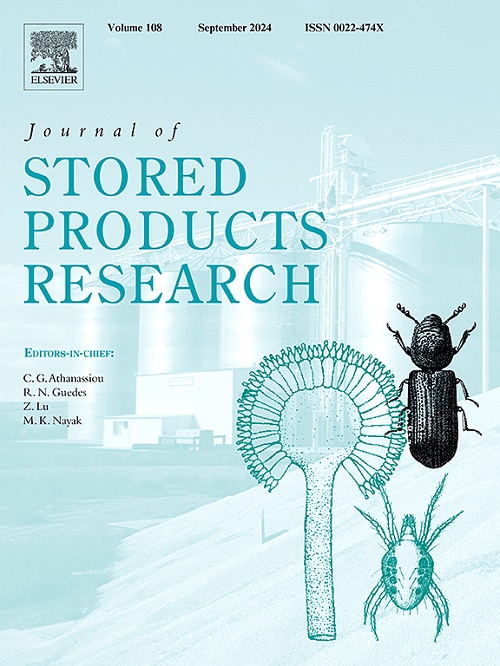Thermal death kinetics of pests in tobacco leaves as influenced by heating rates and life stages
IF 2.7
2区 农林科学
Q1 ENTOMOLOGY
引用次数: 0
Abstract
Thermal death kinetics of insects are essential for developing effective disinfestation protocols using heating treatments. The thermal resistance of Lasioderma serricorne (F.) (Coleoptera: Anobiidae) and Ephestia elutella (Hübner) (Lepidoptera: Pyralidae) under different life stages were compared using a heating block system (HBS) and the more resistant pest and life stage were selected for further establishing the thermal death kinetic model at four temperatures under a specified heating rate. The results indicated that when the two target pests were in the same life stage, the tobacco beetle was more heat-tolerant than the tobacco moth and selected for the following thermal death kinetic studies. With the stronger heat tolerance than that of adults and eggs, the mortality rate of tobacco beetle larvae was determined as influenced by the 5 heating rates, showing that the heating rate of 5 °C/min resulted in higher mortality as compared to 0.1 or 0.5 °C/min and similar mortality to 1 and 10 °C/min, and selected for further studies to effectively simulate rapid radio frequency heating. The 0th-order kinetic response model was more suitable for describing thermal death curves of L. serricorne larvae. The minimum holding time required to kill all the test pests was 48, 28, 8, and 2 min at 51, 53, 55, and 57 °C, respectively. The activation energy required to eliminate L. serricorne was calculated to be 553.8 kJ/mol. The information gained from this study is instrumental in designing efficient heat treatment protocols for disinfesting tobacco leaves.
加热速率和生命阶段对烟草叶片中害虫热死亡动力学的影响
昆虫的热死亡动力学是制定有效的除害方案,利用加热处理至关重要。采用加热阻滞系统(HBS)比较了不同生活期的绢皮蝇(F.)(鞘翅目:无蛾科)和衣蛾(h bner)(鳞翅目:Pyralidae)的热抗性,选择抗性较强的害虫和生活期,进一步建立特定升温速率下4种温度下的热死亡动力学模型。结果表明,当两种目标害虫处于同一生命阶段时,烟草甲虫比烟草蛾具有更强的耐热性,并被选为后续热死亡动力学研究的对象。由于烟草甲虫幼虫的耐热性强于成虫和卵,因此确定了5种加热速率对其死亡率的影响,结果表明,5°C/min的加热速率比0.1或0.5°C/min的加热速率更高,与1和10°C/min的加热速率相似,并选择了进一步研究,以有效模拟快速射频加热。第0阶动力学响应模型更适合于描述丝绒夜蛾幼虫的热死亡曲线。在51°C、53°C、55°C和57°C条件下,杀死所有试验害虫所需的最小保温时间分别为48、28、8和2 min。通过计算得到,去除羊角菌所需的活化能为553.8 kJ/mol。本研究获得的信息有助于设计有效的烟叶除虫热处理方案。
本文章由计算机程序翻译,如有差异,请以英文原文为准。
求助全文
约1分钟内获得全文
求助全文
来源期刊
CiteScore
5.70
自引率
18.50%
发文量
112
审稿时长
45 days
期刊介绍:
The Journal of Stored Products Research provides an international medium for the publication of both reviews and original results from laboratory and field studies on the preservation and safety of stored products, notably food stocks, covering storage-related problems from the producer through the supply chain to the consumer. Stored products are characterised by having relatively low moisture content and include raw and semi-processed foods, animal feedstuffs, and a range of other durable items, including materials such as clothing or museum artefacts.

 求助内容:
求助内容: 应助结果提醒方式:
应助结果提醒方式:


